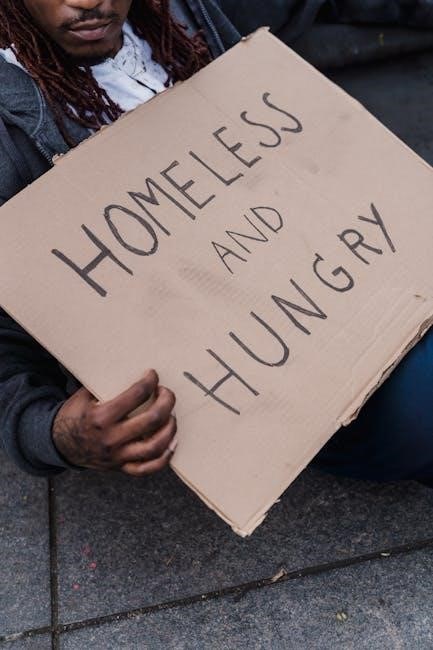Savage Inequalities, a 1991 book by Jonathan Kozol, examines the stark educational disparities in America, exposing systemic inequities in school funding and the impact of segregation and poverty.
Overview of the Book and Its Author
Savage Inequalities: Children in America’s Schools, written by Jonathan Kozol in 1991, is a groundbreaking exploration of educational disparities in the U.S. Kozol, a former teacher and acclaimed author, examines the stark differences in funding, resources, and opportunities between schools in affluent and impoverished areas. Through vivid storytelling and data, he highlights how systemic inequalities perpetuated by segregation, racism, and economic disparities deny low-income students access to quality education. The book has become a seminal work in the discussion of educational justice, sparking critical conversations about equity and reform in American schools.
Jonathan Kozol’s Perspective on Educational Inequality
Jonathan Kozol’s perspective on educational inequality is rooted in his deep critique of systemic disparities in the U.S. education system. He argues that these inequalities are not accidental but are perpetuated by societal structures, including racial segregation, economic disparities, and political neglect. Kozol emphasizes that the stark differences in school funding and resources between affluent and impoverished areas reflect a broader moral failure. He advocates for systemic change, challenging the nation to recognize the inherent value of all children and ensure equitable opportunities for learning; His work underscores the urgent need for reform to address the entrenched injustices faced by marginalized communities.

The Link Between Inequality and Segregation
Kozol highlights how systemic inequality and segregation perpetuate educational disparities, disproportionately affecting minority and low-income students by denying them access to equal resources and opportunities.
Systemic Inequalities in School Systems
Kozol reveals how systemic inequalities in school systems perpetuate educational disparities, often rooted in funding mechanisms that favor affluent districts. Schools in low-income areas face severe resource shortages, inadequate facilities, and underqualified teachers. These systemic issues disproportionately affect minority and low-income students, limiting their access to quality education. For instance, East St. Louis and Chicago illustrate how segregation and poverty entrench inequality, leading to stark contrasts in educational opportunities. Such disparities underscore the deep-seated structural flaws in the American education system, which perpetuate cycles of poverty and limit social mobility for marginalized communities.
The Role of Segregation in Perpetuating Educational Disparities
Segregation plays a pivotal role in perpetuating educational disparities, as highlighted in Savage Inequalities. Racial and socioeconomic segregation often leads to underfunded schools in marginalized communities, depriving students of essential resources. Kozol emphasizes how historical and systemic segregation creates a cycle of inequality, where schools in predominantly minority areas receive less funding and support. This segregation not only affects educational outcomes but also reinforces broader social and economic divides, perpetuating a system where opportunity is often determined by race and zip code rather than potential or merit.

Funding Disparities in Education
Funding disparities in education are a central issue in Savage Inequalities. Wealthy schools receive abundant resources, while low-income schools struggle with basic necessities like textbooks and heating.
How School Funding Affects Educational Resources
School funding significantly impacts the availability of educational resources. Wealthier districts afford advanced technology, libraries, and experienced teachers, while underfunded schools struggle with basics like textbooks and heating. This disparity creates unequal learning environments, with low-income students often lacking access to essential tools for academic success. Insufficient funding also limits extracurricular programs and support staff, further disadvantage marginalized communities. Kozol highlights how financial inequities perpetuate systemic educational inequalities, denying students in poorer areas the resources necessary for a quality education.
The Impact of Economic Disparities on Low-Income Schools
Economic disparities profoundly affect low-income schools, leading to inadequate facilities and insufficient resources. Many schools lack basic necessities like heating, clean water, and updated textbooks. Teacher shortages and high turnover rates exacerbate these challenges, depriving students of stability and qualified instruction. Additionally, budget constraints limit access to technology and extracurricular activities, hindering students’ opportunities for holistic development; These conditions perpetuate a cycle of disadvantage, as under-resourced schools struggle to provide the foundation needed for academic success and future opportunities. Kozol emphasizes how economic inequality directly undermines the quality of education in these communities.

Racial and Ethnic Disparities in Education
Kozol highlights how racial and ethnic disparities in education stem from systemic segregation and discrimination, perpetuating unequal access to resources and opportunities for marginalized students.
Legacy of Segregation in American Schools
The legacy of segregation deeply influences modern educational inequalities, as Kozol illustrates. Historically, segregated schools perpetuated racial and socioeconomic divides, limiting access to quality education for marginalized communities. Discriminatory policies, such as redlining and unequal funding, entrenched these disparities. Kozol argues that the remnants of segregation are evident in underfunded schools, inadequate resources, and a lack of opportunities for students of color. These systemic inequalities alienate students, diminish their chances of success, and perpetuate cycles of poverty. The book underscores how historical segregation continues to shape contemporary educational inequities, highlighting the moral and educational costs of such divides.
Cultural and Socioeconomic Factors Contributing to Inequality
Cultural and socioeconomic factors significantly contribute to educational inequality, as highlighted in Savage Inequalities. Kozol emphasizes how poverty and cultural marginalization create barriers for students. Low-income schools often lack resources, affecting students’ ability to succeed. Additionally, cultural biases in curricula and teaching methods alienate minority students, reinforcing systemic inequities. These factors intersect with racial segregation, perpetuating disparities. Kozol argues that addressing these issues requires equitable funding and culturally responsive education. Without such changes, the cycle of inequality persists, limiting opportunities for marginalized students and deepening societal divisions. The book calls for a comprehensive approach to tackle these intertwined challenges.
The Human Cost of Educational Inequality
Educational inequality deeply impacts students’ life chances, limiting opportunities and perpetuating poverty. It denies access to quality education, hindering social mobility and fostering long-term disadvantages for marginalized communities.
Impact on Students’ Life Chances and Opportunities
The stark disparities in education drastically limit students’ future prospects, perpetuating cycles of poverty and inequality. Many students in underfunded schools lack access to basic resources, such as textbooks, heat, and qualified teachers, hindering their ability to compete academically. These systemic inequalities often result in lower graduation rates, reduced college opportunities, and limited career pathways. Kozol highlights how these conditions disproportionately affect marginalized communities, trapping students in a cycle of disadvantage. The emotional toll is profound, as students confront the reality of a system that fails to provide equal opportunities for success, ultimately undermining their potential and aspirations.
Teachers’ Perspectives on Resource Deprivation
Teachers in underfunded schools often describe their working conditions as dire, with inadequate materials, overcrowded classrooms, and insufficient support staff. Many express frustration at the lack of basic resources, such as functional classrooms, updated textbooks, and technology. These challenges force educators to improvise, frequently using their own funds to provide essentials. Despite their dedication, teachers witness the toll resource deprivation takes on students’ learning and morale. The systemic neglect of schools in low-income areas leaves educators feeling undervalued and powerless, highlighting the broader societal failure to prioritize equitable education for all children.

Case Studies: Examples from Across the U.S.
Savage Inequalities highlights cities like East St. Louis and Chicago, where schools in impoverished areas suffer from inadequate resources, pollution, and systemic segregation, vividly illustrating educational injustice.
East St. Louis: A City Plagued by Poverty and Pollution
East St. Louis, a city ravaged by poverty and environmental neglect, exemplifies the stark realities of systemic inequality. Its schools lack basic necessities like heat, textbooks, and safe water, while pollution exacerbates health issues among students. Kozol highlights the devastating impact of racial segregation and economic abandonment, which traps generations in cycles of poverty. Teachers like Irl Solomon describe the challenges of educating students in such dire conditions, where teenage pregnancies and limited opportunities further entrench inequality. The city’s plight underscores the urgent need for systemic change to address these savage inequalities and ensure educational justice for all.
Chicago: A Tale of Two School Systems
Chicago’s education system reflects a stark divide between affluent and impoverished areas. While schools in wealthy neighborhoods boast ample resources, those in low-income districts struggle with overcrowding, outdated textbooks, and insufficient funding. Kozol’s exploration reveals how systemic inequality perpetuates disparities, with Chicago’s South Side schools facing severe underfunding and neglect. This contrasts sharply with well-funded schools in affluent areas, highlighting a system that prioritizes privilege over equity. The tale of two school systems in Chicago underscores the broader struggle for educational justice and the need to address the systemic roots of these inequalities.
Policy and Reform Efforts
Addressing systemic educational inequalities requires comprehensive policy reforms. Efforts to redistribute funding and resources face resistance from affluent communities. Advocates emphasize the need for equitable solutions.
Challenges in Achieving Educational Equity
Achieving educational equity faces significant obstacles, including resistance from wealthier communities and systemic biases. Savage Inequalities highlights how funding disparities and segregation perpetuate inequality, with low-income schools lacking basic resources. Kozol argues that policy reforms often fail to address root causes, such as racial and economic segregation. Additionally, political and economic interests frequently hinder efforts to redistribute resources equitably. These challenges underscore the need for systemic change to ensure all students receive a fair and quality education, regardless of their background or location.
Potential Solutions to Address Systemic Inequalities
Tackling systemic inequalities requires comprehensive reforms. Kozol advocates for equitable funding models, ensuring all schools receive adequate resources. Policies addressing segregation, such as magnet programs and cross-district busing, could help integrate schools. Increasing community involvement and teacher training can improve educational quality. Federal and state governments must prioritize education funding, particularly for low-income areas. By addressing the root causes of inequality, society can create a more just educational system, fostering opportunities for all students to thrive. These solutions aim to dismantle the barriers highlighted in Savage Inequalities and promote true educational equity.
Savage Inequalities remains a powerful critique of educational injustice, urging systemic change to address disparities in funding and access, ensuring equity for all students.
Reflecting on the Legacy of Savage Inequalities
Savage Inequalities remains a landmark critique of educational injustice, exposing systemic disparities in funding and resources. Kozol’s work has inspired advocacy for equity, highlighting the enduring impact of segregation and poverty on schools. While progress has been made, the book’s themes remain relevant, challenging society to address deep-rooted inequalities. Its legacy underscores the need for continued efforts to ensure all students, regardless of background, receive a fair and equitable education. The fight for educational justice, as Kozol so powerfully illustrates, is far from over.
The Ongoing Fight for Educational Justice
The fight for educational justice continues, with Savage Inequalities serving as a catalyst for reform. Kozol’s findings reveal persistent disparities in funding, resources, and opportunities, particularly in low-income and minority communities. Advocates emphasize the need for systemic change, including equitable funding models and policy interventions. Despite progress in awareness, significant barriers remain, such as racial and economic segregation. The book’s legacy inspires ongoing activism, urging society to prioritize education as a fundamental right for all. The struggle for equity demands collective action and sustained commitment to ensure every child accesses quality education, regardless of their background.
References and Further Reading
For deeper insights, explore Savage Inequalities: Children in America’s Schools by Jonathan Kozol (1991). Additional resources include studies by IA Shmerlina and VI Zhukovskiy, which discuss educational disparities and systemic inequalities. Articles from 2019 to 2024 highlight ongoing issues in low-income schools, such as funding gaps and resource deprivation. Works like The Great Leveler provide broader perspectives on inequality. Academic databases and educational journals offer extensive analyses of Kozol’s arguments and their relevance today. These sources collectively emphasize the need for equitable reform in education.